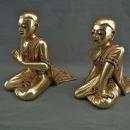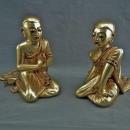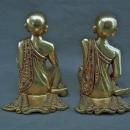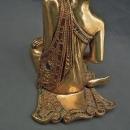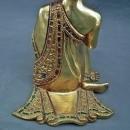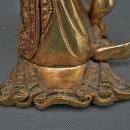Pair of Burmese Gilded Lacquered Wooden Sculptures Buddhist Monks Sariputta & Moggallana








$800.00
A pair of finely carved wooden figures in the Burmese Mandalay style, heavily gilded with gold leaf and lacquered 20th century Myanmar.
The artwork depicts two of Buddha's main disciples, Sariputta and Moggallana. They are dressed in the traditional flowing Buddhist monastic robes called Samghati, with decorative bands adorned with molded lacquer relief work known as "thayo" and embedded with cut glass jewels backed with green and crimson foil, known as "hman-zi-shwei-cha."
Moggallana is kneeling with his hands pressed together in Namaskara mudra. Sariputta sits in a position of listening with his arms resting on his upper legs.
The statuettes showcase the artist's exceptional skills with stunning hand-sculpted details, including traditional shaved heads (mundanā) required for Buddhist monks. The faces are modeled with serene expressions, clearly depicting Burmese features such as protruding noses flanked by large almond-shaped eyes, arched eyebrows, and plump lips. The hands and feet of the monks have detailed fingers and toes.
DIMENSIONS:
Sariputta
Height: 27 cm (10.63 inches).
Width: 18 cm (7.09 inches).
Depth: 22 cm (8.66 inches).
Moggallana
Height: 27 cm (10.63 inches).
Width: 20 cm (7.87 inches).
Depth: 23.5 cm (9.25 inches).
CONDITION: The item is in very good condition, with a minor old natural split on the back of the Sariputta near the robe, where the sculpture was made from two pieces of wood.
Please see all the pictures in the listing since they are part of the object's condition description.
NOTE: Images of the Sariputta and Moggallana often are found in Burmese artwork. This type of carved wooden and lacquered sculptures of Moggallana and Sariputta were used in temples, monasteries, and home shrines where they were placed before images of the Buddha as part of a shrine (hpaya khan).
Sariputta and Moggallana were two key disciples of Siddhartha Gautama, who later became known as the Buddha in the early days of Buddhism. They were close companions of the Buddha and played crucial roles in the development and spread of Buddhist teachings. Here is an overview of each disciple:
Sariputta (Sāriputta):
Sariputta, also known as Upatissa, was born in a Brahmin family. He was highly regarded for his intellect and wisdom even before encountering Buddhism.
Conversion to Buddhism: Sariputta, along with his friend Moggallana, sought spiritual truth. After meeting the monk Assaji, who was one of the first five disciples of the Buddha, Sariputta gained insight into the Dharma and decided to follow the Buddha's path.
Role as Chief Disciple: Sariputta became the chief disciple of the Buddha, renowned for his deep understanding of the Dharma and his ability to explain complex concepts in simple terms. He was often praised by the Buddha for his wisdom.
Contributions: Sariputta was known for his skill in teaching and his analytical approach to the Dharma. His contribution to the Buddhist monastic community was significant, and he played a key role in helping to establish the structure of the Sangha (monastic community).
Moggallana, also known as Maudgalyayana, came from a Brahmin family as well. He was a childhood friend of Sariputta, and they both renounced worldly life together in search of spiritual truth.
Conversion to Buddhism: Like Sariputta, Moggallana was inspired to seek enlightenment after meeting the monk Assaji. After hearing Assaji's concise explanation of the Dharma, Moggallana realized the profound nature of the teachings and decided to follow the Buddha.
Role as Chief Disciple: Moggallana was recognized as the second chief disciple of the Buddha, often praised for his mastery of supernatural powers, such as telekinesis and mind-reading. However, the Buddha emphasized that such powers were not the essence of spiritual attainment.
Contributions: Moggallana was instrumental in supporting the monastic community and helping fellow monks on their spiritual path. He was known for his compassion and commitment to the practice of meditation.
Both Sariputta and Moggallana were highly esteemed for their wisdom, compassion, and dedication to the Buddha's teachings. Their contributions to the early Buddhist community, both in terms of doctrinal understanding and the establishment of the monastic order, were crucial in preserving and transmitting the Dharma. Sariputta and Moggallana are remembered as exemplary disciples who played pivotal roles in the early spread of Buddhism.
REFERENCES:
Fraser-Lu, S., Burmese Crafts: Past and Present, Oxford University Press, 1994.
Isaacs, R., & T.R. Blurton, Burma and the Art of Lacquer, River Books, 2000.
Lowry, J., Burmese Art, Victoria and Albert Museum, 1974.
McGill, F. (ed.), Emerald Cities: Arts of Siam and Burma, 1775-1950, Asian Art Museum, 2009.
Śāriputra: https://en.wikipedia.org/wiki/%C5%9A%C4%81riputra
Maudgalyayana: https://en.wikipedia.org/wiki/Maudgalyayana
